
Mass Storage and Retrieval at Rome Laboratory, USAF
Joshua L. Kann, Brady W. Canfield, Capt, USAF, Albert A. Jamberdino, Bernard J. Clarke, Capt, USAF, Ed Daniszewski, and Gary Sunada, Capt, USAF
Rome Laboratory IRAP 32 Hangar Rd. Rome NY 13441-4114 315- 330-4581
Preface: Although first published in 1996, this USAF paper is a classic primer on molecular storage devices. Some of the underlying material substrates have changed, but all in all, the only difference is that today, in the year 2000, the density levels have ramped up; in some cases, quite considerably. Regardless, the architectures as discussed in this paper have remained remarkably consistent.-- Ed.
Abstract
As the speed and power of modern digital computers continues to advance, the demands on secondary mass storage systems grow. In many cases, the limitations of existing mass storage reduce the overall effectiveness of the computing system. Image storage and retrieval is one important area where improved storage technologies are required. Three- dimensional optical memories offer the advantage of large data density (on the order of 1 Tb/cm3) and faster transfer rates because of the parallel nature of optical recording. Such a system allows for the storage of multiple-Gbit sized images, which can be recorded and accessed at reasonable rates. Rome Laboratory is currently investigating several techniques to perform three-dimensional optical storage including holographic recording, two-photon recording, persistent spectral-hole burning, multi-wavelength DNA recording, and the use of bacteriorhodopsin as a recording material. In this paper, the current status of each of these on-going efforts is discussed. In particular, the potential payoffs as well as possible limitations are addressed.
1.0 Introduction
The national security requirements of the United States have undergone fundamental changes in just a few short years. The cold war and incumbent strategic threats have given way to new Third World threats and regional conflicts. In order to achieve Global Awareness and, if necessary, implement Dynamic Planning and Execution, vast amounts of information must be collected, stored, processed, and disseminated through an interoperable Command, Control, Communications, Computing, and Intelligence (C4I) architecture.
Air Force C4I systems must effectively store, retrieve, and manage massive amounts of digital data. Optoelectronic and massively parallel computing demands multi-terabit memories and near real-time write and retrieval rates. Current Air Force systems range from centralized Terabyte and Petabyte storage comprised of large objects (images) to distributed heterogeneous databases that contain many small and large objects (open source databases). Although technologies for storage, processing, and transmission are rapidly advancing to support centralized and distributed database applications, more research is needed to handle massive databases efficiently and achieve the Air Force goal of "Information Dominance".
Our goal is to retain data for potential future analysis in a cost-effective manner. The more relevant data would remain on-line, say for five years, organized with the most relevant data accessible in the least amount of time. It is expected that 2 to 5 Terabytes of new data will be processed each day. Thus the total size of the database (both on-line and off-line) could be as large as 20 Petabytes with about 300 Terabytes of data stored on-line. It becomes apparent that new storage devices (primary, secondary and, even, tertiary) for large multimedia databases, as well as data pathways with the required capacity, must be developed. Access time is about 5 seconds for the data less than a week old, about 30 seconds for data under two months old, and on the order of minutes for the data up to 10 years old.
Over the years, Rome Laboratory has nurtured a comprehensive program, developing revolutionary new storage techniques that meet the various demands for data storage and retrieval. Our group is currently investigating various approaches to ultra dense, highly parallel three-dimensional optical memory storage systems. This article traces the recent history of optical data storage and updates the status of Rome Laboratory's research efforts in this field.
In the mid-1970s
and early 1980s optical storage reached the consumer market. Industry giants
like RCA and Philips developed and marketed playback devices and large format
"laser disks" for home movie viewing. While laser disks never generated
a large, broad-stream consumer market (VCR is still the dominant technology
for home movie viewing), compact disks (CDs) are now the primary means of distributing
and listening to high-fidelity music. The introduction of laser diode devices
made compact disk systems a viable consumer product. Laser diodes operating
within the near-IR (infrared) spectrum allowed 1m embossed pits to be easily
detected. The new laser technology, in combination with powerful error detecting
and correcting codes, enabled SONY and Philips to introduce the first CD audio
product a decade ago.
Better optical media, more powerful laser diodes, and very precise, low-mass optics have propelled optical disk technology to a practical, powerful system[1-3]. The next-generation device introduced in the mid-1980s provided a flexible write-once, read-many (WORM) capability. This enabled end-users to record and playback computer data from the same drive. Rome Laboratory has continued to sponsor work in this area to further exploit the benefits of new storage technology. An early Rome Laboratory prototype used an argon laser to record and playback digital data from a 12.5-inch plastic-based optical disk. Further investment led to the delivery in 1982 of a large-capacity optical jukebox for satellite imagery storage and retrieval applications. The jukebox holds 100 WORM disks that provide a storage capacity of one Terabyte.
The third generation
optical disk, today's rewritable systems, offer record, playback, and erase
capability. These magneto-optical (MO) disks are composed of a rare-earth alloy
and transition materials, which often include terbium, iron, and cobalt elements.
Optical disk storage is playing a larger role in mass data storage for many
military applications; particularly, those applications that require reliable
operation under harsh operational environments. Commercially, MO disk drives
have also made an impact on the market.
Present devices store one-dimensional (serial) information in a two-dimensional plane. Three-dimensional memory devices store two-dimensional information (bit planes) throughout a volume. A 3-D memory is, therefore, a single memory unit where three independent coordinates specify the location of information. 3-D memories are generally classified as bit-plane-oriented and holographic. Bit-oriented 3-D memories, where each bit occupies a specific location in 3-D space, differ significantly from 3-D holographic memories. With holographic memories the information associated with stored bits is distributed throughout the memory space. Bit-oriented 3-D memories generally use amplitude recording media while holographic memories use phase recording media. In bit-oriented 3-D memories, the coordinates that specify the location of information can be spatial, spectral, or temporal, giving rise to a variety of 3-D memory concepts that use different materials with various properties. For example, materials that exhibit 2-photon absorption are the basis for true volume memories, while materials wherein spectral holes can be burned, provide a storage medium for spectral/spatial storage. In addition, materials that exhibit the photon-echo effect could, in principle, lead to temporal/spatial storage.
In 3-D memory, information is partitioned in binary planes that are stacked in the third dimension. One memory operation is performed on the entire bit plane, giving rise to a tremendous memory bandwidth increase over conventional 2-D bit-oriented memories. Also, by storing information in volumetric media, we can achieve very high density (1012 bits/cm3). High-speed reading and writing of an entire memory plane then becomes feasible. These considerations make 3-D memory very compatible with emerging, highly integrated parallel array processors and optoelectronic multiprocessors.
In this paper, we discuss the current status of our ongoing efforts in several areas of 3-D memory. Section 2 investigates a variety of 3-D memory storage techniques. Holographic and two-photon storage methods are discussed in detail. Both system and material aspects are addressed. In addition, a less involved discussion is given for three other techniques: Persistent Spectral Hole Burning (PSHB), recording in DNA molecules, and the use of bacteriorhodopsin (BR) as a storage medium. Finally, in Section 3 a summary and some conclusions are provided.
2.0 Various three-dimensional recording techniques
2.1 Holographic data storage Holograms for artistic posters and pictures started gaining popularity in recent years due to the maturation of technologies which produce very pleasing images. These same technologies provide a potential to store data using holography, with smaller system sizes but larger data capacity and faster throughput rates[4-6]. This idea is not new to the data storage world, and dates back to the late 60's, but was only recently considered practical due to the emergence of improved critical components such as improved laser diodes, Spatial Light Modulators (SLM), and Charge-Coupled Device (CCD) detector arrays. Holographic memories also process data in parallel, affording fast data transfer rates, high storage density, and small physical size.
A hologram is a recording of the amplitude and phase of a wavefront, which is in contrast to photography, where only the amplitude of the wave is recorded. A hologram is created, or written, by the interference of two beams, an object beam and a reference beam, as shown in Fig. 1. When a hologram is read using one beam, the original wavefront (amplitude and phase) is reconstructed, as shown in Fig. 2. To create the extremely high data capacity, data is stored in the same physical space of the media, but is written and read by multiplexing. Multiplexing is a way of giving each set of data a unique address. Typical multiplexing methods used for holographic storage are angular, spatial, and phase multiplexing.

Figure 1. System used to record holographic data. A reference beam and object beam are interfered within the recording medium. The resulting interference pattern is recorded within the medium.

Figure 2. System used to read previously recorded holographic data. The reference beam playback the recorded data. The data is then imaged onto a CCD.
Angular multiplexed holograms, shown in Fig. 3, change the angle of incidence of the reference beam on the storage medium without changing the location of the area, or spot, being recorded. This is one method of recording several holograms, or pages of information, on top of each other in the same location. Figure 4 shows how angular multiplexing changes the reference beam angles but the recording location does not change. The schematic diagram shows three collimated beams with different angles of incidence on the storage medium. Note all three beams stay within a common location. An important consideration for angular multiplexing systems is the need for sophisticated beam steering devices, since without it this method can result in some very complex optical paths for large storage systems.

Figure
3. Basic premise of angle multiplexing. Multiple holograms stored in the
same spot, all recorded with a reference beam at a different angle.
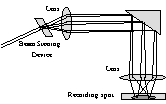
Figure 4. A system used to perform angular multiplexing. A beam steering device is used to modulate the angle of incidence of the reference beam.
Phase multiplexing uses reference beams with different phase fronts to write composite holograms associated with the object beam. Each reference beam consists of a set of plane waves with a unique phase distribution. This phase distribution represents the address of the recorded information. Holographic memories using phase multiplexing have the same data storage capacity as angle multiplexing, but involve different problems generating the phase codes. We are working with Surface Optics Corporation to develop a compact 3-D storage system using this method, which will store 26 Gigabytes and have a footprint of one square foot for the entire system.
Spatial multiplexing is a method used to change the recording spot location to a different location in the medium. In volume holography, holograms recorded on top of each other will ultimately reach saturation of the recording medium unless redirected to a different spot. Spatial multiplexing can be combined with angle or phase multiplexing to increase the storage capacity of the memory device. Holograms can be stored in one spot up to their practical limit using angular or phase multiplexing, then the information beams are redirected to a different spot using spatial multiplexing to fill the next area with the new pages of information.
Optimizing the number of holograms per spot is the key to finding the best system. The most successful efforts apply angle and spatial multiplexing. Researchers with the Psaltis Group at the California Institute of Technology have demonstrated the storage of 160,000 individual holograms in a 2 cm x 2 cm x 4 cm crystal of LiNbO3. The photorefractive LiNbO3 crystal is thick, and can have a high number of holograms per spot. The thickness determines the number of holograms that can be stored in a given area of material before reaching the point where saturation occurs and the data resolution decreases. The higher the density of data, the lower its resolution. However, thick holograms require more complex optics for data addressing. Thin holograms cannot store as much as thick holograms, but can have simpler optics, and therefore a simpler system. We are funding two efforts with Holoplex, Inc to make data storage systems out of thin film photopolymer disks. Each of these disks will store 2.8 Terabits, with 17 ms access time, and each disk can be recorded in 60 sec. Overall holographic storage looks more reliable than current solid state or disk memories since the individual bits of information are stored collectively throughout a homogeneous recording medium. Recorded information is not susceptible to the same kind of losses magnetic or magneto-optic devices have from dust, scratches, or other imperfections. A holographic recording medium is generally a solid volume of homogeneous material, requiring few manufacturing constraints to make, where semiconductor memories require fine line lithography. Since information is stored optically, the system is "free-space" system and does not require elements of the system to be in contact with each other to operate, leading to greater speed and reliability.
2.2 Two-Photon Storage In addition to our holographic work, we are also investigating 3-D memory storage which utilizes two-photon absorption[7-8]. Currently, we are working with Call/Recall to develop a two-photon based optical memory. Such a system is capable of data capacities up to 1012 bits/cm3. This system takes advantage of the parallel nature of optical recording, allowing for a page of digital data to be written (or read) simultaneously. We have invested in this technology for the past 5 years and have recently developed a demonstration WORM system. It is hoped to have a functional read/write/erase system within the next few years. Currently, a great deal of work is being done both in the system and material areas of this technology. The basic premise of a two photon recording system is the simultaneous absorption of two photons whose combined energy is equal to the energy difference between the initial and final states of the recording material. This simultaneous absorption results in a change in the molecular structure of the material. This structural change alters various properties of the material, including index of refraction, the material's absorption spectrum and the material's fluorescence spectrum. Therefore, by intersecting two optical beams, either spatially or temporally, the material's optical properties can be altered locally and addressed anywhere within a three-dimensional space. Digital data is written in this fashion, with the ultimate limitation on storage capacity set by diffraction effects in the optical system. Data readout is accomplished by probing the material with a single read beam to measure a change in one of the material's optical properties.
The current system architecture uses picosecond pulses of the first and second harmonic (1 = 1064 nm, 2 = 532 nm) of a Nd:YAG laser. A schematic of the optical system is shown in Fig. 5. Image storage (recording) is shown in Fig. 5(a), while image retrieval (readout) is shown in Fig. 5(b). Digital information is recorded in the two-photon material as pages of digital data, the data planes separated in the axial direction. (Currently, the material is fabricated in a cubic shape, but we are investigating other geometries.) The input (data) arm of the system ( = 532 nm) is spatially modulated with a SLM and imaged to the proper plane within the cube. A second, addressing beam ( = 1064 nm),
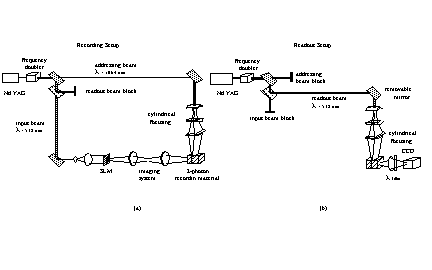
Figure 5. The recording (a) and readout (b) systems used for a 2-photon memory. In (a), recording occurs where the spatially modulated input beam and cylindrically focused addressing beam overlap. The system is readout by measuring the excited fluorescence of each recorded data plane as shown in (b).
propagating orthogonal to the input beam, is cylindrically focused throughout the cube. A page of data is recorded when the input beam and addressing beam simultaneously illuminate the image plane. The axial resolution is limited by the divergence of the addressing beam, while the lateral resolution is determined by diffraction effects and/or aberrations in the input arm. A more detailed discussion of data parallelism versus density is given later in this section.
Readout is accomplished
by measuring the fluorescence of the material. The input beam is blocked and
the 532 nm beam is cylindrically focused to read the proper data page. For the
unwritten material, the 532 nm beam is unabsorbed and passes through the system.
However, for the written form of the material, the readout beam is absorbed,
exciting a fluorescence at a longer wavelength. The readout plane is then imaged
through a wavelength selective filter onto a CCD. Thresholding of the individual
pixels of the CCD is performed to digitize the data.
A variety of recording materials have been proposed. The proper material must posses several key characteristics in order to be considered. Some of these characteristics are: photocromisim (the change of chemical structure after excitation by light), a fluorescence in one of the two chemical states, stability of both states at room temperature, ability to read data 106 times without loss of information, high quantum efficiency of the read form fluorescence, and a wide enough wavelength shift between the read beam and peak of the fluorescence spectrum to prevent cross-talk. In this paper, we will discuss one of the more promising candidates, Spirobenzopyran (SP).
Spriobenzopyran molecules are composed of two distinct molecular components linked by a sp3 hybridized carbon. Upon excitation simultaneous absorption of a 532 nm photon and a 1064 nm photon the chemical state of the material is altered, as shown in Figs. 6(a) and 6(b). The unwritten form, Fig. 6(a), is colorless in appearance and shows strong absorption in the ultraviolet ( < 400 nm) portion of the spectrum. However, the written form, Fig. 6(b), is colored in appearance and shows strong absorption in the 550 nm region. The fluorescence spectra of SP, shown in Fig 6(c), is peaked around 600 nm. Note that the this peak is sufficiently separated from the read wavelength to prevent cross-talk during readout. Figures 6(a) and 6(b) show two species of SP. To fabricate solid, stable recording materials, the SP is dispersed in polymers such as PMMA. This alters the absorption and fluorescence spectrums slightly, but does not effect the basic system premise discussed in the previous paragraphs.
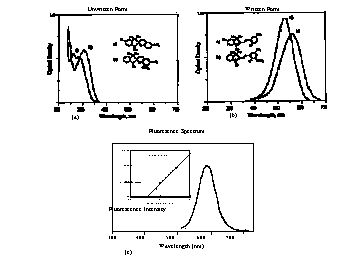
Figure 6. The absorption and fluorescence spectrum for two different types of SP compositions. In (a) the spectrum for the unwritten form is shown, while in (b) the spectrum for the written form is shown. In (c) the fluorescence of the written form is shown.
Currently, a working WORM system has been built and is used for writing and readout of pages of digital data. The system uses a 1cm3 cube of SP for a recording material. The system has been used to record 100 planes of data with a separation of 80 m between planes. The input beam is spatially modulated with the use of chrome masks. The mask's resolution is 100 x 100 m2. Dynamic focusing is performed by moving the cube. Currently no dynamic aberration correction is performed. With a demagnification in the system of 3.4, the recorded bits are 30 x 30 x 80 m3 resulting in a density of 1 Mb/cm3. Data readout is accomplished with the use of a HeNe laser ( = 543.5 nm), and a 640 X 480 CCD array. While the system's density is well below our desired goal of 1 Tb/cm3, the system allows us to demonstrate and improve on the current technology.
Using this system initial Bit Error Rate (BER) characterization will be performed. In order to be competitive with existing mass storage systems, raw BERs on the order of 10-6 must be obtained. In addition, we have begun work with the University of Pittsburgh on an optoelectronic cache memory system which will act as cache memory between the optical memory, and a uniprocessor or multiprocessor computing environment. By caching a page of data during a memory read, the relatively slow access time to the user will be significantly lowered, since the access time of the cache memory is orders of magnitude faster than the two-photon memory.
There are several obstacles to overcome in this rapidly developing technology. The first involves cube fabrication. Important characteristics are surface quality and material homogeneity. Surface quality is especially important, since defects in the material's surface will result in scattering of the light beam and optical aberrations of the transmitted beam. Using injection molding techniques, it is hoped to produce surfaces with RMS roughness of approximately 0.25 m. Another significant obstacle is the current need for high intensity beams for data recording. The probability of recording a mark (i.e. causing a local transition of the material from the unwritten to written form) is proportional to the product of the two beams intensities. Typically very high intensities are needed to alter the material (intensities on the order of 1.6 GW/cm2 are typical). In addition to designing the materials for lower powers, we are currently investigating modifying the material's energy gap to allow writing at existing laser diode wavelengths. Finally, we are hoping to design materials which can be used in a read/write/erase system. We are currently exploring an exciting class of material which have shown repeated read/write/erase cyclability.
A major concern with the optical system is the ability to dynamically image through various layers of the material. As different planes are recorded in the cube, the magnification and amount of spherical aberration in the system changes. To dynamically compensate for this requires very expensive high performance imaging optics. One way to overcome this obstacle is to fabricate the recording material in a three-dimensional disk format. Using this 3D-CD approach, pages of images are stored as "spokes" in the rotating disk. The addressing beam is again cylindrically focused through the side, while the recorded page of data is imaged into the proper plane of the 3D-CD. Since the disk is constantly rotating, the conjugate planes remain in the same location and the magnification remains constant. In addition, with the use of a properly designed compensator in the input arm, spherical aberrations can be corrected.
A major design issue is the trade-off between data density and parallelism during the recording operation. Due to the parallel nature in imaging spatially modulated beams, whole arrays of data can be recorded at once. Assuming that a 1024 x 1024 SLM is used, it is possible to simultaneously write up to 1 Mb of data. However, as larger data pages are written, the longitudinal distance the addressing beam must remain collimated increases. Unfortunately, since the addressing beam diverges as it propagates, parallel recording results in the need for larger spacing between data planes, and thus, lower data densities. An alternative approach would be to write data in a bit-by-bit fashion allowing the density to be limited only by the Airy spot diameter of the two beams. While this drastically increases the data density, it eliminates the parallel nature of data recording. In Table I, three different data recording format are presented.
|
|
||||||||
| Data Format |
|
|
|
|
|
|
||
| Bit |
|
|
|
|
|
|
||
| Vector |
|
|
|
|
|
|
||
|
|
|
|
|
|
|
|||
| Image |
|
|
|
|
|
|
||
|
|
|
|
|
|
|
|||
|
|
|
|
|
|
|
|||
Table 1. The Maximum Volumetric Density (MVD) is shown for various data recording formats.
In the bit format bits are recorded serially. In the vector scheme, a vector (a column or row) of data is recorded in parallel, while with the image scheme two-dimensional data arrays are recorded at once. Computations are performed assuming Gaussian beam propagation of the addressing beam. The beam width and length are derived from the size of the imaged data array within the cube, while the thickness corresponds to the minimum plane-to-plane spacing of data pages which can be used. Finally, the maximum volumetric density (MVD) correspond to the maximum data density which can be stored within the cube. Note, that going from a bit-by-bit recording format to one in which 1024 x 1024 data arrays are stored in parallel increases the parallelism by 106 bits/recording step, but results in a density reduction of 104 bits/cm3. It is important to point out that these calculations neglect aberrations in the input path's imaging system which becomes worse when larger arrays, resulting in larger field angles, are recorded.
2.3 Other Techniques In addition to our work with holographic and two-photon memory, we also have ongoing programs in other multi-dimensional optical storage systems. These approaches are all developmentally in a much earlier stage, but each offers significant advantages in terms of capacity, throughput or material fabrication. Persistent Spectral Holeburning (PSHB) takes a step ahead of one-bit-per-spot memories, allowing multiple bits to be written, erased and rewritten in a single location and offering the potential of storing up to 1015 bits/cm3. The two techniques currently being explored are frequency-domain and time-domain PSHB.
Frequency-domain Holeburning involves burning "holes" in a material's absorption band [9]. The ideal material has many narrow, individual absorption lines that blend together into a broad absorption band. When writing information, a frequency-tunable laser would focus on a single spot, and scan down in wavelength while sending a stream of bits. At peak laser output (one pulse at a certain frequency), an absorbing center would make the transition from one stable state to another, so when the same spot is spectrally scanned there would be "holes" at certain frequencies which would indicate the presence of stored bits; this is one-wavelength (non-gated) holeburning. However, since non-gated holeburning tends to be volatile, a second, fixed wavelength is used (gated holeburning) to make the change permanent but still erasable.
Time-domain (also known as photon echo) holeburning also utilizes spectral holes for memory storage, but relies on coherent optical transient phenomena to store data[10]. Two temporally modulated beams are set to spectrally interfere, and that interference pattern is stored in the form of spectral holes. This concept is spectrally analogous to holograms, which are spatially constructed from the interference between the reference and modulated (object) beam. When a reference beam illuminates the spot for reading, the material emits a delayed coherent output signal that resembles the temporal waveform of the original data pulse.
There are a number of technical challenges to overcome before PSHB becomes viable for storage, however. One issue revolves around how to gate the material; current techniques inflexible or irreversible. Another problem is temperature; typically, practical operating temperatures have not exceeded 10 degrees Kelvin, making it difficult and costly to write and maintain data. One particular Rome Lab effort is an exception, achieving room temperature holeburning with a novel material, but even this requires considerable development before an acceptable storage density has been attained. These obstacles have slowed PSHB advancement, and have yet to be resolved before any practical applications can be produced.
Biological molecules would certainly be Darwin's media of choice for three dimensional recording. Serendipitous natural selection has given researchers a promising material in the protein bacteriorhodopsin (bR). This material is the light transducing protein found in the bacterium Halobacterium halobium. This light harvesting protein is found in the purple membrane of the bacterium. This membrane is essential, protecting from the harsh environment of salt marshes where the salt concentration is six times that of ordinary sea water. Bacteriorhodopsin provides the H. Halobacterium the ability to convert light energy to a metabolically useful form when conditions do not allow for aerobic respiration. This flexibility allows the bacterium to switch from photosynthesis to aerobic respiration depending on the environmental conditions. The conditions of the marsh dictate that the protein be resistant to thermal and photochemical damage. These qualities combined with its natural cyclicity (exceeding 106) of the protein make it an ideal media for optical recording[11].
The photocycle of bR is shown in Fig. 7. The main photocycle consists of the left-hand side of the figure[12]. In the course of studying this material, a branching reaction was identified. This is identified by the P and Q states. The resting state of the molecule, the bR state, can be elevated to the K state by the primary photochemical event. The other transitions are caused by thermal reactions and result once again in the resting state, bR. The entire photocycle takes about 6-10 milliseconds depending on the temperature. The interesting reaction which creates this branched photocycle happens when the last intermediate state, O, is converted by light to P which subsequently decays to Q. P and Q are the only states involved in the branched reaction and it exists as its own entity to the original photocycle. The Q state is the one used for recording data and is created by a sequential one-photon process. This implies that the timing of the reaction must be precisely controlled. The material must be illuminated a second time while the molecules are in the O state about 2 ms after the initial writing pulse. The room temperature lifetime of the written state is roughly five years.
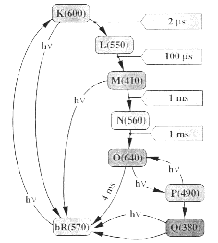
Figure 7. The photocycle of bR.
The architecture shown in Fig. 8 is used to record on this media. This setup is similar to the architecture of the two-photon approach discussed earlier, with the main difference being that data beam and the addressing beam not only must intersect at a given data plane in the material, but they must follow a timed sequence with the paging pulse activating the media followed by the data pulse 2 ms later changing the O state to the P state, as shown in Fig. 9. The entire memory can be bulk thermally erased, or selective page erasure is possible by illuminating with blue light ( = 413 nm). This wavelength will convert both the P and Q states back to bR. Alternately, the entire memory can be bulk erased with incoherent light in the 360 - 450 nm range. Some investigators have suggested, however a WORM system as the amount of bacteriorhodopsin required for a memory capable of storing many hundreds of megabytes is on the order of milligrams and mass quantities of this material can be made through fermentation processes. Ultimately, this may provide extremely cheap memory media. Individual bulk erasers could be provided for those wishing to re-use the media.
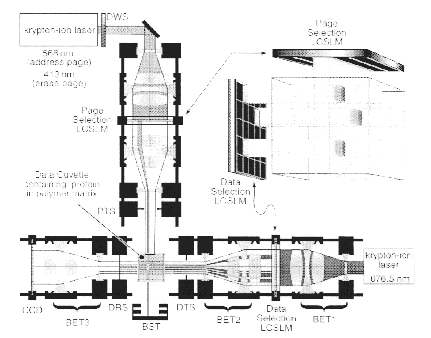
Figure 8. Schematic diagram of the branched-photocycle volumetric memory prototype base on bR.
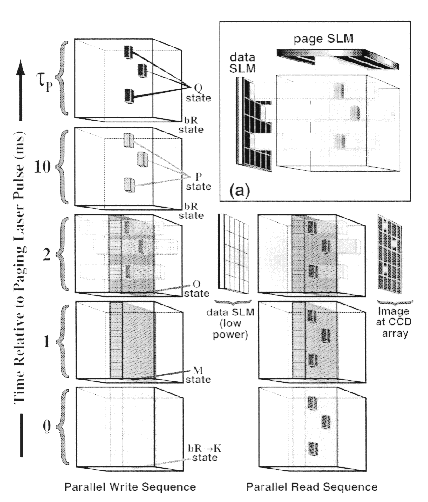
Figure 9. A schematic diagram of the parallel write and read timing sequences, with time progressing from top to bottom.
Volumetric 3-D optical recording is a relatively new process in the data storage world, but not nearly as new as multi-wavelength DNA storage - based on the use of enhanced deoxyribonucleic acid (DNA) polymers as the three dimensional structure in prototype optical volumetric memories[13]. DNA polymers provide a robust and programmable synthetic material that can be organized into a wide variety of pre-determined structures. Because of the precise geometric and distance requirements of Frster energy transfer - which allows for the use of a single wavelength excitation wavelength and multiple wavelength emissions during the read process- energy is transferred at the molecular level, with almost 100% quantum efficiency, similar to photosynthesis in plants. Organized DNA chromophore structures, both natural and synthetic, produce relatively intense sub-micron fluorescent light sources. The intensity levels in the synthetic structures are within the range of commercially available detectors. The development of a customized optoelectronic read/write system is presently a primary research objective to make a practical DNA optical memory.
Working with Nanotronics, Inc, DNA polymers have been successfully attached to glass, aluminum, and silicon, to determine compatibility for use in a practical solid architecture in future systems. DNA chromophores exhibited energy transfer properties when attached in the solid state comparable to their solution state, and they exhibited quenching properties in the solid state dramatically superior to properties in a solution state. Experiments demonstrated the potential for multiwavelength optical storage material using DNA polymers - the early efforts demonstrated a 6 color response, and using this property, ongoing efforts show optical data storage using this organic material will allow very high data density - on the order of 100 bits/micron (100 times the storage of present storage densities). A conceptual DNA storage device is shown in Figure 10. As more devices shrink in size, synthetic DNA will be a major player in future technologies which require nanotechnology.
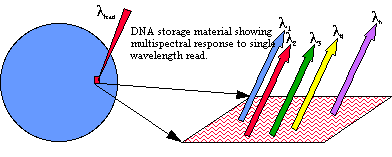
Figure 10. Visualization of a recorded spot in DNA material.
3.0 Summary and Conclusions
In summary, the technologies described here have potential in all three memory requirements, primary, secondary, and tertiary. Three-dimensional optical memory development can be applied to the secondary and tertiary memory requirements offering large data capacities, medium access time, and archivability. The 3-D optical memory concepts with terabit capacities, gigabit throughput rates, and 10-nanosecond access times are potential solutions to the primary and secondary memory requirements.
With our two-photon and holographic work we have developed working demonstration systems, and anticipate operational systems within the next few years. Unfortunately, the prospects of a future system are still somewhat limited by key system components such as SLM's, fast (non-mechanical) beam deflectors, two-dimensional error correction and detection encoders/decoders and dynamic focusing/aberration control. However, these systems ultimately offer the advantage of extremely high data densities, and reasonable data I/O rates due to the parallel nature of data recording/readout. We are also pursuing some more elaborate techniques and materials such as spectral hole burning and DNA recording systems and bacteriorhodopsin as a recording medium. These techniques represent technologies which may be further from maturation, but represent significant progress in mass data storage technology.
References
-
Haritatos, Fred N., "High Performance Optical Disk Systems," SPIE/OSA Optical Data Storage Conference, Feb. 1991.
Haritatos, Fred N., "Optical Recording," Defense Electronics, vol. 25, no. 10, Sept. 1993.
-
Haritatos, Fred N., "High Performance Optical Disk Systems for Tactical Applications," IEEE, May 1991.
Burr, G., Mok, F., Psaltis, D., "Large-Scale Holographic Memory: Experimental Results," SPIE Proceedings, vol. 2026, p. 630-641, 1993.
-
Mok, F.H., "Angle-Multiplexed Storage of 5000 Holograms in Lithium Niobate," Optics Letters, vol. 18, no. 12, p. 915-917, June 1993.
Burr, F. Mok, D. Psaltis, Large-Scale Holographic Memory: Experimental Results, SPIE Proceedings, vol. 2026, 1993, p. 630-641.
-
Esener, S., Fainman, Y., Ford, J.E., Hunter, S., "Two-Photon Three-Dimensional Memory Hierarchy," (Photonics for Computers, Neural Networks and Memories, San Diego CA, 22-24 July 1992), Proceedings of the SPIE-The International Society for Optical Engineering 1993, 1773, p. 346-355, 1993.
Dvornikov, A.S., and Rentzedis, P.M., "Two-Photon 3-D Optical Memory," IEEE Proc. of 1994 Conference on Solid State Memory Tech., p. 109-118, 1994.
- Maniloff, E., Altner, S., Bernet, S., Graf, F., Renn, A., Wild, U., "Spectral Hole Burning Holography in Optical Memory Systems," SPIE Proceedings, vol. 2026, p. 592-603, 1993.
- Babbitt, W.R. and Mossberg, T.W., "Time-Domain Frequency-Selective Optical Data Storage in a Solid State Material," Optical Communications, vol. 65, p. 185, 1988.
- Horspool, W., Song, P, CRC Handbook of Organic Photochemistry and Photobiology, CRC Press, Boca Raton, Chap. 33, 1995.Birge, R., "Protein-Based Branched Photocycle Three-Dimensional Optical Memories," Rome Laboratory Final Report F30602-93-C-0135, 1996
- Heller, M., Tu, E., "DNA Optical Storage," U.S. Patent Application, Pending.
21st, The VXM Network, https://vxm.com